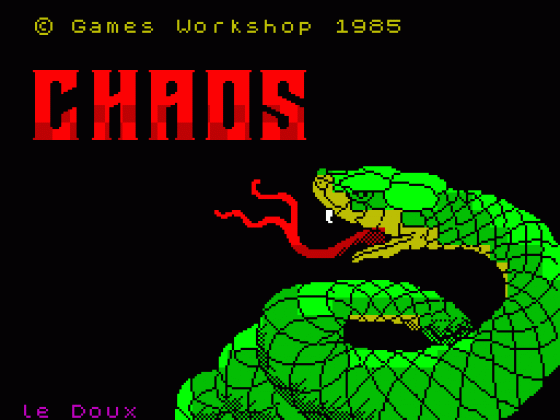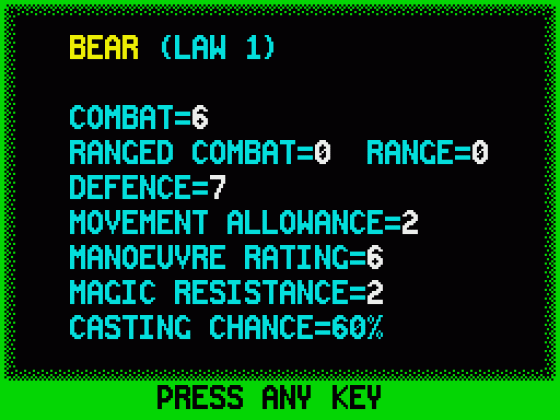
Micro Mart
 5th August 2004
5th August 2004
Categories: Review: Software
Author: Dan Whitehead
Published in Micro Mart #811
This week, guest columnist Dan Whitehead looks back fondly on a simple concept that seems to work time and again.
Retro Mart: Chaos
Jeff Goldblum needed a glass of water, Laura Dern's hand and an island full of rampaging dinos to demonstrate chaos effect. The lanky buffoon. Brit programmer Julian Gollop managed to encapsulate the exact same thing over a decade before, on the ZX Spectrum, using less memory than was used to CGI over Jeff's bald spot. He even called the game Chaos, for the love of Clive!
You see, there's a tendency these days to demand games be bigger, faster, longer. Much like Billy Idol and his rebel yell, we cry "More, more, more!" Fancy AI routines, intricately complex level design, free-roaming gameplay - these are the things that games publishers waggle in our faces, insisting this is what we need, like the cheap brassy tarts they surely are.
Retro gamers understand the glaring fallacy behind this obsession that, the more you add, the better things must surely get. Hundreds of hyped games are relegated the bargain bins every week to disprove this lunatic theory. The truth is actually a zen-like piece of contradiction... sometimes, the simpler something is, the more complex it can be. And nothing demonstrates this better than Chaos.
For the seven people who've never played it, Chaos is a battle between up to eight wizards (made up of any combination of human and CPU players). Each wizard is allocated a random selection of spells - from ranged attacks, magical weapons and defences, and a menagerie of mythical beasts which can be summoned and controlled. You're then set down in a one-screen, jet black arena and the last wizard left standing is the winner. Simple. And yet...not.
You see, within this most basic of frameworks beats a game engine which still give modern strategy games a run for their money. The graphics are sparse - small and barely animated renditions of everything from snakes to zombies to (if you're lucky) gold dragons.
Beautifully Precise
But there's something beautifully precise about these miniature monsters. With only a smattering of pixels, Gollop managed to capture their individual essence with a minimalism that borders on the genius. How else to explain the malevolent swish of the vampire's cape, the eerie pulsing of the wraith and the gorilla, locked forever in his macho chest-beating pose?
But it's the gameplay that throbs with potential. Some spells are harder to cast than others, denoted by a percentage rating. A giant rat is pretty easy - you get a 90% chance of success or higher. The fabled Gold Dragon comes with a 10% chance of working. But there are ways to even the odds. You can cast the spell as an illusion - guaranteeing success, but leaving your creature open to instant oblivion should another wizard cast "Disbelieve" on it. Or you can work to alter the fundamental magical balance of the arena in your favour. Some spells carry a "Law" attribute, others "Chaos". The more spells are cast of one element, the more the entire arena shifts to that end of the mystical spectrum. The more Chaotic things are, the easier it becomes to cast Chaos spells, and vice versa.
And herein lies the genius of Chaos. From a handful of tiny graphics and black screen, Gollop created a world with almost infinite potential - the game never plays the same way twice. From the slow spread of a Gooey Blob, to the spell-granting Magic Wood, there's no end of ways to claw back victory, or sink into defeat. Sure, you can predict what a computer-controlled wizard will do (they tend to divert their forces to the most dangerous threat in their radius) but there are times when the CPU will actually do something that you didn't expect. They'll take a gamble. They'll act out of desperation. In other words, these tiny clusters of pixels, sharing a mere 48k brain between them, will act like real people.
When the latest next-gen shooter boasts adversaries that can "think" and "react", it's hard to be impressed.
The processing power now thrown into creating the illusion of independent thought means that the unpredictable has become, well, predictable. When a program smaller than the average JPEG pulls off the same feat, it's like finding a robot made from a shoe-box and rubber bands that can solve quadratic equations. It shouldn't work. The complex shouldn't come out of the simple. Yet in the games of yesteryear, it did. From the most BASIC building blocks, Chaos proves that magic is simple in more ways than one...
Coming Up
Next week, Shaun debriefs you after the excellent Classic Gaming Expo UK. Find out what went on...





